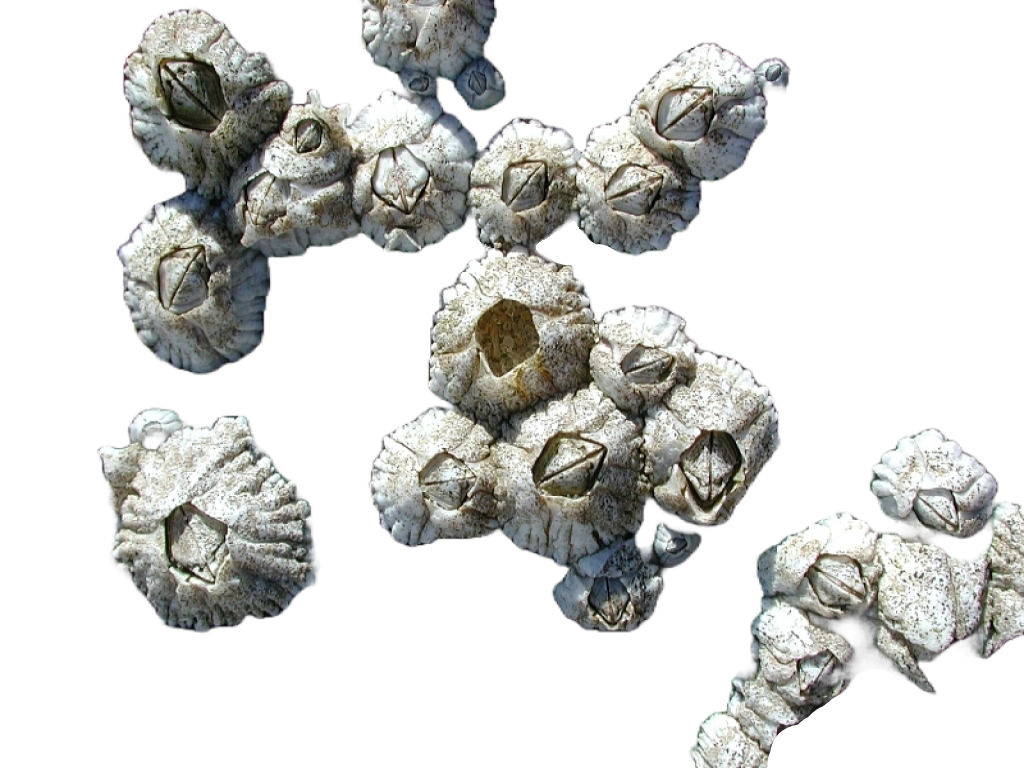Barnacles
Balanidae

Sessile crustaceans with feather-like arms
Barnacles are small animals that belong to the family Balanidae. Their hard shells may make them resemble mussels, but barnacles are actually crustaceans! They live in large groups and can be found on rocks and boulders along the coast. A barnacle looks like a small cone with a lid on top. When the barnacle wants to eat, it opens the lid and stretches out its feathery appendages to catch food. It looks like they are using a fan! Inside its shell, the animal itself lies on its back, and the catchment arms are actually the crustacean’s modified legs. Barnacles filter water to catch plankton, which they then eat.
An illustration of a barnacle in cross-section shows how the crustacean lies on its back inside the shell.
The feather-like feeding arms are used to capture food.
Photo: Kim-Hansen-CC-BY-SA
The species Balanus crenatus is one of the barnacle species found in Swedish waters. Here, it grows on a blue mussel.
Photo: Christoph-Noever-CC-BY
Feeding barnacle.
Photo: Christoph-Noever-CC-BY
Sticking to hard surfaces
One of the most impressive things about barnacles is their ability to attach to hard surfaces. Barnacles have a strong natural cement that they use for attachment. Once the barnacle has attached, it can remain in place for many years. The fact that barnacles attach so tightly to many surfaces has caused many problems for humans.
Barnacles like to attach to the hull of boats or other man-made structures in the sea. For many years, toxic paints were used on boats to avoid barnacle growth; nowadays we are trying to replace it with environmentally friendly alternatives. But the barnacles’ ability to attach is not just a problem! Researchers are studying barnacle cement to find out how to use it as a source of inspiration to create stronger and more durable adhesives in industry.
Barnacles can pose problems for humans, such as when they attach to boat hulls.
Photo: Sinikka-Halme-CC-BY-SA
Barnacles that attach to mobile animals can benefit from being moved around, as seen here where some barnacles have attached to the shell of a hermit crab.
Photo: Yuriy-Kvach-CC-BY-SA
Even large animals, like humpback whales, can have barnacles growing on them.
Photo: Gregory-Slobirdr-Smith-CC-BY-SA
A large colony of barnacles on granite rocks.
Photo: gratuit-CC-BY
The species common barnacle is widespread in Sweden, growing here alongside blue mussels.
Photo: Ryan-Hodnett-CC-BY-SA
Barnacles on a glass bottle.
Photo: Korytnyansʹka-Viktoriya-CC-BY-SA
Barnacle on a blue mussel shell.
Photo: Arnstein-Ronning-CC-BY-SA
A nauplius larva is the free-swimming larval stage of the barnacle.
Photo: ottolarink5-CC-BY-SA
The longest penis among animals
Barnacles are hermaphrodites, meaning they have both male and female reproductive organs. They are therefore able to mate with themselves, but it is much more common for them to mate with another barnacle. Since barnacles are attached, mating usually takes place between neighbours. To be able to reach their neighbour, barnacles actually have the longest penis in the animal world in relation to their body size! The penis can have a length of up to eight times the length of the animal’s body, which allows them to reach other barnacles. After mating, the penis detaches, and it grows back in time for the next mating.
Barnacles go through two different larval stages before they develop into adults. First, they hatch as small planktonic larvae, called nauplius larvae. These larvae are small and translucent, swimming around in the water and eating microscopically tiny aquatic organisms. After shedding their skin about six times, they transform into something called cyprid larvae. The job of the cyprid larva is to look for a suitable place to attach itself, and it has no mouth and cannot eat. Once it has chosen a location, it immediately begins to produce the cement that attaches the barnacle to the surface, and build its shell. When attached, the larva transforms into an adult barnacle.